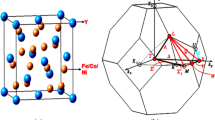Abstract
We have investigated the electronic structure and chemical bonding in yttrium dicarbide. We have constructed a quantum-chemical model for the effect of orientational disordering of the C2 units within the YC2 structure on its electronic properties. We have established that the conduction properties of the dicarbide may vary from metallic to semiconductor type, depending on the relative orientation of the C2 dimers within the lattice.
Similar content being viewed by others
References
Kh. D. Gol'dshmidt,Interstitial Alloys [in Russian], Mir, Moscow (1971).
L. Toth,Transition Metal Carbides and Nitrides [in Russian], Academic Press, New York-London (1971).
N. I. Medvedeva, V. P. Zhukov, and V. A. Gubanov,Inorg. Mater.,25, No. 10, 1409–1414 (1989).
V. P. Zhukov, D. L. Novikov, N. I. Medvedev, and V. A. Gubanov,Zh. Strukt. Khim.,30, No. 1, 27–31 (1988).
J. Li and R. Hoffmann,Chem. Mater.,1, No. 1, 84–101 (1989).
J. R. Long, R. Hoffmann, and H. J. Meyer,Inorg. Chem.,31, No. 10, 1734–1740 (1992).
J. R. Long, J. F. Halet, J. Y. Saillard, et al.,New J. Chem.,16, No. 8/9, 839–846 (1992).
E. Ruiz and P. Alemany,J. Phys. Chem.,99, No. 10, 3114–3119 (1995).
T. Gulden, R. W. Henn, O. Jepsen, et al.,Phys. Rev. B,56, No. 14, 9021–9029 (1997).
A. L. Ivanovskii, A. A. Sofronov, and U. N. Makurin,Teor. Éksp. Khim.,35, No. 5, 289–294 (1999).
A. F. Wells,Structural Inorganic Chemistry, Claredon, Oxford (1984).
A. L. Ivanovskii, V. P. Zhukov, and V. A. Gubanov,Electronic Structure of Refractory Transition Metal Carbides and Nitrides [in Russian], Nauka, Moscow (1990).
M. V. Ryzhkov and A. L. Ivanovskii,Zh. Strukt. Khim.,40, No. 4, 630–638 (1999).
A. A. Rempel',Ordering Effects in Nonstoichiometric Interstitial Compounds [in Russian], Nauka, Ekaterinburg (1992).
A. I. Gusev,Usp. Fiz. Nauk,170, No. 1, 3–40 (2000).
V. L. Yupko, G. N. Makarenko, and Yu. B. Paderno,Refractory Carbides [in Russian], Naukova Dumka, Kiev (1970), pp. 148–154.
Additional information
Institute of Solid State Chemistry, Ural Branch, Russian Academy of Sciences, 91 Pervomaiskaya ul., Ekaterinburg 620219, Russia. Translated from Teoreticheskaya i Éksperimental'naya Khimiya, Vol. 36, No. 4, pp. 206–212, July–August, 2000.
Rights and permissions
About this article
Cite this article
Ivanovskii, A.L., Sofronov, A.A. Quantum-chemical modeling of the electronic structure and chemical bonding in yttrium dicarbide with orientational disordering of C2 dimers. Theor Exp Chem 36, 187–193 (2000). https://doi.org/10.1007/BF02522749
Received:
Revised:
Issue Date:
DOI: https://doi.org/10.1007/BF02522749



